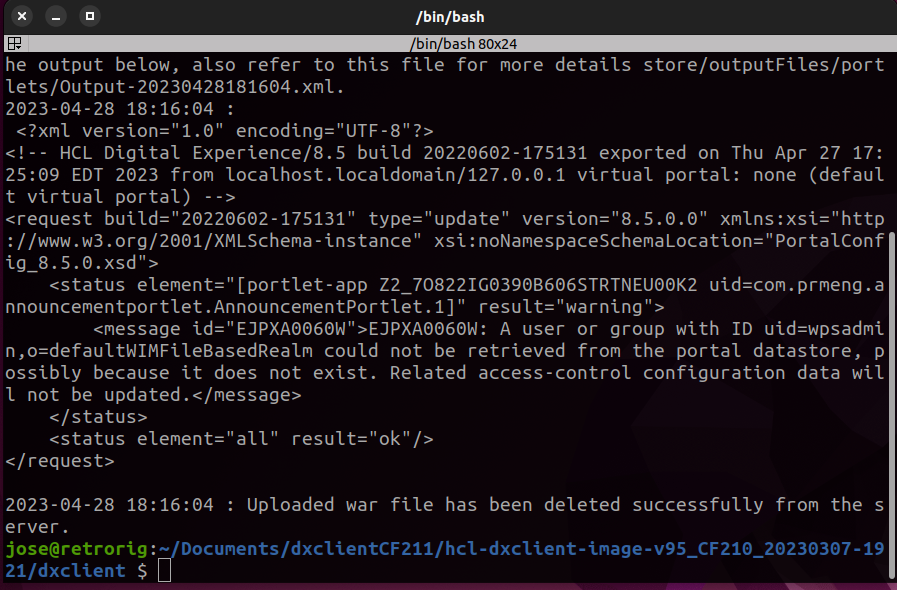Published April 29, 2023

Jose Osornio
Principal Solutions Architect
As software developers, we constantly seek ways to optimize our workflows and speed up our tasks. When dealing with enterprise Portal solutions like HCL Digital Experience (DX), our standard process for deploying a custom portlet application involves building the asset, logging into the portal software using the correct credentials, and installing the portlet via the Administration interface. This process is outdated and prone to errors since it requires several manual steps and clicks on the screen. Imagine having to repeat this tedious process repeatedly as you continue to develop and deploy your application.

However, with the recent release of HCL Digital Experience (DX) 9.5 CF19, developers now have access to a new toolset that can streamline this process and integrate their development process with a CI/CD pipeline. The DXClient, in conjunction with DXConnect, significantly improves the development experience in this aspect.
DXClient is a tool that developers can execute from their workstations. It is capable of taking artifacts developed locally and deploying them to a DX server deployed on-premises platforms in standalone, clustered, or farm-topologies and supported Kubernetes platforms. This tool is available as a Docker image and as a Node.js-based CLI tool. Detailed instructions on how to install DXClient are available from the HCL DX product documentation page. page. The preferred way is to use the DXClient docker image since the Node.js-based tool has been deprecated since CF196. You will need to have Docker installed on your workstation if you use the Docker image.
DXConnect is a servlet-based application deployed on top of IBM WebSphere Application Server in the HCL DX 9.5 CF19 and later deployments, under the Configuration Wizard profile – cw_profile. DXConnect enables the DXClient tool to connect over an HTTP or HTTPS connection from a client development workstation or remote server to a source or target HCL DX 9.5 server to execute certain tasks requested via DXClient commands.
The installation is done through a ConfigEngine task and is documented in detail in the HCL DX product documentation page. It can be installed onto on-premises platforms in standalone, clustered, or farm-topologies and supported Kubernetes platforms. Note that DXConnect runs on the Configuration Wizard profile in WebSphere Application Server and may not always be running. Ensure that the Configuration Wizard profile is started before using DXConnect.
After installing DXClient and DXConnect, you can significantly accelerate your development workflow. To illustrate, let’s go through an example of deploying a new Portlet, creating a page, and adding the portlet to the page. Prior to the availability of DXClient, performing these tasks required manual execution via the DX user interface, but now, with just a single command, these tasks can be accomplished seamlessly.
Prerequisites:
To confirm that DXClient is correctly installed, use the “dxclient -V” command. If installed correctly, you should see the version number of DXClient.

Next, we will now use DXClient to create a new page in our example DX site and deploy our portlet application to that page. The creation and placement of the portlet is done using the XML Access file which you can download here.

From the command line, execute the ‘deploy-portlet’ command giving the -warFile and -xml file arguments. All other required arguments have been set in our config.json file but can also be entered as arguments in this command if needed.
In my workstation, the war file and xml access location is under: /home/jose/Documents/HCL/portlet-sample
dxclient deploy-portlet -xmlFile /home/jose/Documents/HCL/portlet-sample/DeployPortlet.xml -warFile /home/jose/Documents/HCL/portlet-sample/AnnouncementPortlet.war
Note: ensure the Configuration Wizard profile is running. In my environment, it is installed under: /opt/IBM/WebSphere/AppServer/profiles/cw_profile as server1
On a successful deployment, you will see output similar to this:

Navigate back into the DX site and ensure that the new page has been created along with the Portlet deployed.

You can continue using this same command as you continue your Portlet application development to deploy your latest changes.
Deploying Portlets and pages is just the beginning. Depending on your DX CF level, you are able to use the following commands to speed up your development process.
It is also possible to use DXClient in your CI / CD pipeline to automate deployments. HCL DX 9.5 provides sample pipelines for use with the DXClient tooling to demonstrate how the deployment of portlets, Script Applications, Themes, DX Application, export and import of WCM libraries, etc., can be automated.
In conclusion, the availability of the DXClient and DXConnect tools have significantly improved the development experience for software developers. The traditional manual process of deploying a custom portlet application has been replaced by a streamlined process that integrates with CI/CD pipelines. With DXClient, developers can deploy artifacts developed locally to a DX server deployed on-premises or on supported Kubernetes platforms. By automating the deployment of portlets, Script Applications, Themes, DX Application, export, and import of WCM libraries, etc., the DXClient tooling is an essential tool for any enterprise Portal solutions like HCL Digital Experience.
https://help.hcltechsw.com/digital-experience/9.5/containerization/dxclient.html
https://help.hcltechsw.com/digital-experience/9.5/containerization/dxconnect.html
https://help.hcltechsw.com/digital-experience/9.5/config/cw_run.html